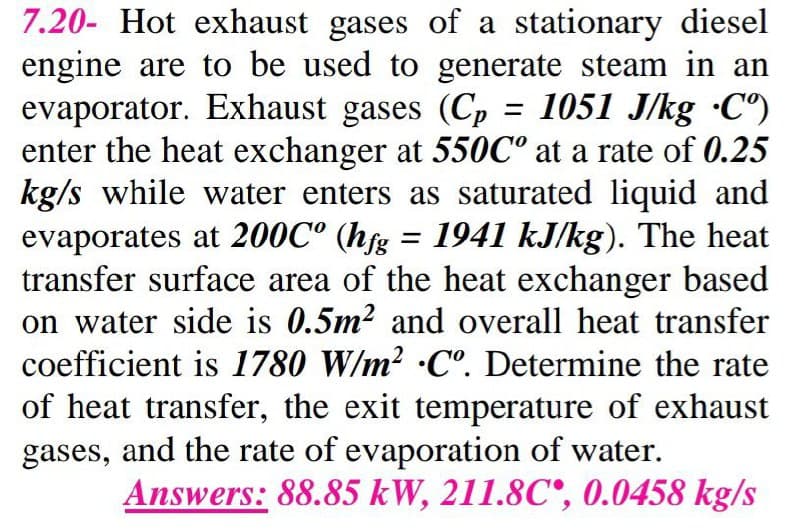7.20- Hot exhaust gases of a stationary diesel engine are to be used to generate steam in an evaporator. Exhaust gases (Cp = 1051 J/kg •C°) enter the heat exchanger at 550C° at a rate of 0.25 kg/s while water enters as saturated liquid and evaporates at 200C° (hfg = 1941 kJ/kg). The heat transfer surface area of the heat exchanger based on water side is 0.5m? and overall heat transfer coefficient is 1780 W/m? ·C°. Determine the rate of heat transfer, the exit temperature of exhaust gases, and the rate of evaporation of water. Answers: 88.85 kW, 211.8C°, 0.0458 kg/s
7.20- Hot exhaust gases of a stationary diesel engine are to be used to generate steam in an evaporator. Exhaust gases (Cp = 1051 J/kg •C°) enter the heat exchanger at 550C° at a rate of 0.25 kg/s while water enters as saturated liquid and evaporates at 200C° (hfg = 1941 kJ/kg). The heat transfer surface area of the heat exchanger based on water side is 0.5m? and overall heat transfer coefficient is 1780 W/m? ·C°. Determine the rate of heat transfer, the exit temperature of exhaust gases, and the rate of evaporation of water. Answers: 88.85 kW, 211.8C°, 0.0458 kg/s
Principles of Heat Transfer (Activate Learning with these NEW titles from Engineering!)
8th Edition
ISBN:9781305387102
Author:Kreith, Frank; Manglik, Raj M.
Publisher:Kreith, Frank; Manglik, Raj M.
Chapter10: Heat Exchangers
Section: Chapter Questions
Problem 10.1DP
Related questions
Question
i need the answer quickly

Transcribed Image Text:7.20- Hot exhaust gases of a stationary diesel
engine are to be used to generate steam in an
evaporator. Exhaust gases (Cp = 1051 J/kg •C°)
enter the heat exchanger at 550C° at a rate of 0.25
kg/s while water enters as saturated liquid and
evaporates at 200C° (hfg = 1941 kJ/kg). The heat
transfer surface area of the heat exchanger based
on water side is 0.5m? and overall heat transfer
coefficient is 1780 W/m2 ·C°. Determine the rate
of heat transfer, the exit temperature of exhaust
gases, and the rate of evaporation of water.
Answers: 88.85 kW, 211.8C°, 0.0458 kg/s
Expert Solution
This question has been solved!
Explore an expertly crafted, step-by-step solution for a thorough understanding of key concepts.
This is a popular solution!
Trending now
This is a popular solution!
Step by step
Solved in 2 steps with 2 images

Knowledge Booster
Learn more about
Need a deep-dive on the concept behind this application? Look no further. Learn more about this topic, mechanical-engineering and related others by exploring similar questions and additional content below.Recommended textbooks for you

Principles of Heat Transfer (Activate Learning wi…
Mechanical Engineering
ISBN:
9781305387102
Author:
Kreith, Frank; Manglik, Raj M.
Publisher:
Cengage Learning

Principles of Heat Transfer (Activate Learning wi…
Mechanical Engineering
ISBN:
9781305387102
Author:
Kreith, Frank; Manglik, Raj M.
Publisher:
Cengage Learning